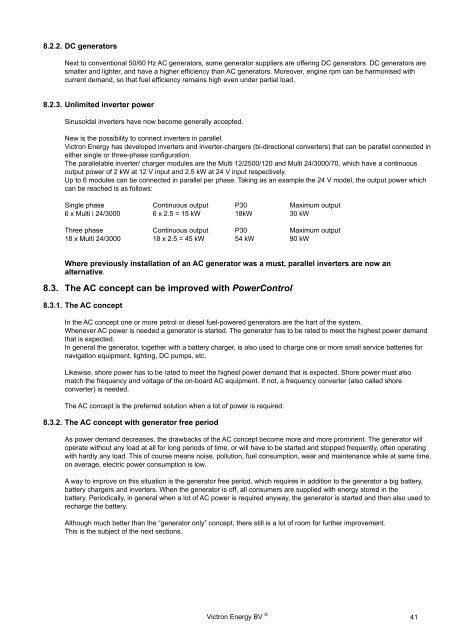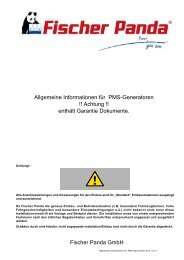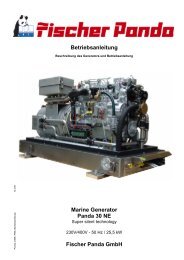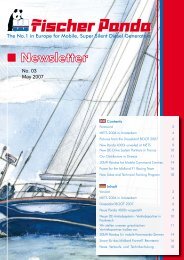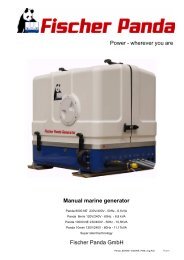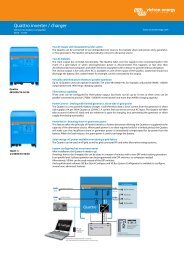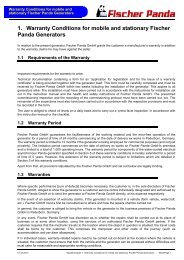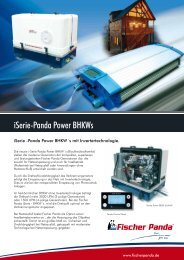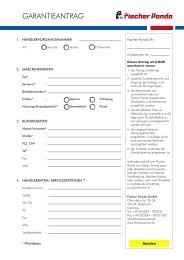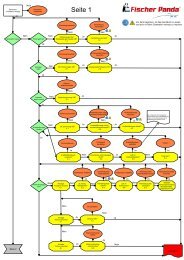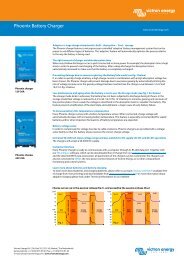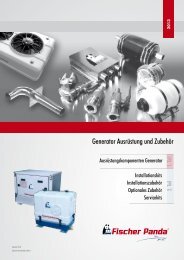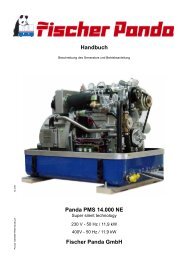Victron "Energy Unlimited" - Utu
Victron "Energy Unlimited" - Utu
Victron "Energy Unlimited" - Utu
Create successful ePaper yourself
Turn your PDF publications into a flip-book with our unique Google optimized e-Paper software.
8.2.2. DC generators<br />
Next to conventional 50/60 Hz AC generators, some generator suppliers are offering DC generators. DC generators are<br />
smaller and lighter, and have a higher efficiency than AC generators. Moreover, engine rpm can be harmonised with<br />
current demand, so that fuel efficiency remains high even under partial load.<br />
8.2.3. Unlimited inverter power<br />
Sinusoidal inverters have now become generally accepted.<br />
New is the possibility to connect inverters in parallel.<br />
<strong>Victron</strong> <strong>Energy</strong> has developed inverters and inverter-chargers (bi-directional converters) that can be parallel connected in<br />
either single or three-phase configuration.<br />
The parallelable inverter/ charger modules are the Multi 12/2500/120 and Multi 24/3000/70, which have a continuous<br />
output power of 2 kW at 12 V input and 2.5 kW at 24 V input respectively.<br />
Up to 6 modules can be connected in parallel per phase. Taking as an example the 24 V model, the output power which<br />
can be reached is as follows:<br />
Single phase Continuous output P30 Maximum output<br />
6 x Multi i 24/3000 6 x 2.5 = 15 kW 8kW 30 kW<br />
Three phase Continuous output P30 Maximum output<br />
18 x Multi 24/3000 8 x 2.5 = 45 kW 54 kW 90 kW<br />
Where previously installation of an AC generator was a must, parallel inverters are now an<br />
alternative.<br />
8.3. The AC concept can be improved with PowerControl<br />
8.3.1. The AC concept<br />
In the AC concept one or more petrol or diesel fuel-powered generators are the hart of the system.<br />
Whenever AC power is needed a generator is started. The generator has to be rated to meet the highest power demand<br />
that is expected.<br />
In general the generator, together with a battery charger, is also used to charge one or more small service batteries for<br />
navigation equipment, lighting, DC pumps, etc.<br />
Likewise, shore power has to be rated to meet the highest power demand that is expected. Shore power must also<br />
match the frequency and voltage of the on-board AC equipment. If not, a frequency converter (also called shore<br />
converter) is needed.<br />
The AC concept is the preferred solution when a lot of power is required.<br />
8.3.2. The AC concept with generator free period<br />
As power demand decreases, the drawbacks of the AC concept become more and more prominent. The generator will<br />
operate without any load at all for long periods of time, or will have to be started and stopped frequently, often operating<br />
with hardly any load. This of course means noise, pollution, fuel consumption, wear and maintenance while at same time,<br />
on average, electric power consumption is low.<br />
A way to improve on this situation is the generator free period, which requires in addition to the generator a big battery,<br />
battery chargers and inverters. When the generator is off, all consumers are supplied with energy stored in the<br />
battery. Periodically, in general when a lot of AC power is required anyway, the generator is started and then also used to<br />
recharge the battery.<br />
Although much better than the “generator only” concept, there still is a lot of room for further improvement.<br />
This is the subject of the next sections.<br />
<strong>Victron</strong> <strong>Energy</strong> BV ©<br />
41


